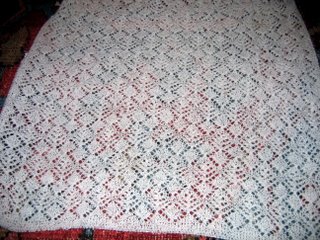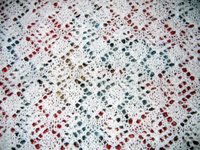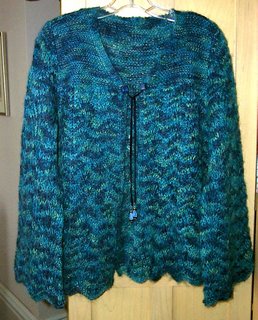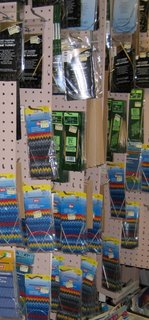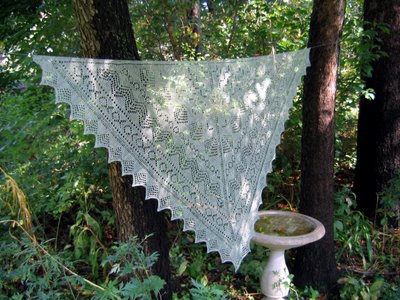 My Cameron Shawl pattern advises that when it comes time to begin a new ball of yarn to leave long tails for weaving in later. The time has come, but I'm a bit leery of my weaving-in skills for such open work as lace. The Cameron uses about 11 balls of Jamieson's Ultra Cobweb (a single-ply yarn), and I concluded that hiding at least 22 ends would really be pushing my luck. Ever the coward, I decided on a different method. Well, two, actually.The Shetland wool would take a simple spit-splice beautifully, but I am concerned about how that kind of join would hold up when it comes to blocking the shawl. I know for a fact that spit-splicing works just fine, but I don't want to test that theory to the max. The prospect that severe blocking will pop the joins and spill my hard-earned stitches all over the floor makes me weak in the knees.
My Cameron Shawl pattern advises that when it comes time to begin a new ball of yarn to leave long tails for weaving in later. The time has come, but I'm a bit leery of my weaving-in skills for such open work as lace. The Cameron uses about 11 balls of Jamieson's Ultra Cobweb (a single-ply yarn), and I concluded that hiding at least 22 ends would really be pushing my luck. Ever the coward, I decided on a different method. Well, two, actually.The Shetland wool would take a simple spit-splice beautifully, but I am concerned about how that kind of join would hold up when it comes to blocking the shawl. I know for a fact that spit-splicing works just fine, but I don't want to test that theory to the max. The prospect that severe blocking will pop the joins and spill my hard-earned stitches all over the floor makes me weak in the knees. So f
or better or worse, I'm using a belt-and suspenders combination of Russian Join and Spit-Splice. 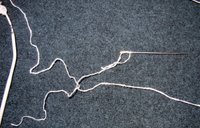 First, the end of the first ball is looped around the start of the new ball. A needle is threaded with one of the ends.
First, the end of the first ball is looped around the start of the new ball. A needle is threaded with one of the ends.
 Next, the first end is woven back on itself, catching the yarn with itty bitty stitches. (If the join were not going to be felted together with the spit splice, I would make the weaving a bit longer.)
Next, the first end is woven back on itself, catching the yarn with itty bitty stitches. (If the join were not going to be felted together with the spit splice, I would make the weaving a bit longer.)
The end is pulled through and tightened, trapping the free end of the other ball. 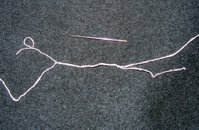
The same technique is applied to the other end. Both ends are now interlinked, with the ends woven back on themselves.
The free ends are then carefully trimmed at a steep angle (not shown). With embroidery scissors, I fray them back so they can feather back into the strand.
 Now for the fun "spit splice" part. I stick the woven section in my mouth and get it wet. (EWWW, you say? The shawl gets washed later!) Then I rub the section briskly between my palms for a minute or two until the join is nice and even. You can see the result here. The join is in the yarn right above the scissors, between the bird's tail and the beak. I bet a skein of sock yarn that you'll never find one of these joins in the finished shawl!
Now for the fun "spit splice" part. I stick the woven section in my mouth and get it wet. (EWWW, you say? The shawl gets washed later!) Then I rub the section briskly between my palms for a minute or two until the join is nice and even. You can see the result here. The join is in the yarn right above the scissors, between the bird's tail and the beak. I bet a skein of sock yarn that you'll never find one of these joins in the finished shawl!
Back to knitting...
 The photo was hasty because I believe in the 5-second rule for flinging knitting on a floor that was not vacuumed immediately prior to the flinging. (I would rather knit than vacuum, dontcha know.) Come to think of it, I should probably exclude white UFOs from that rule...
The photo was hasty because I believe in the 5-second rule for flinging knitting on a floor that was not vacuumed immediately prior to the flinging. (I would rather knit than vacuum, dontcha know.) Come to think of it, I should probably exclude white UFOs from that rule...








